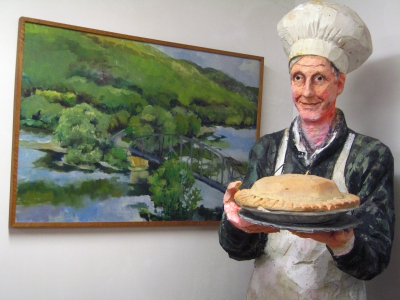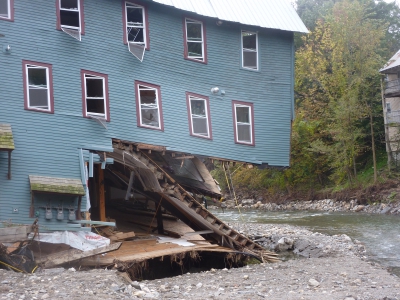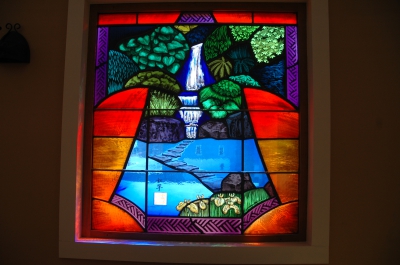By Arlene Distler
The Whetstone Brook curves along the southern edge of Brattleboro from the west, emptying into the Connecticut River. For a while Williams Street follows it, dotted with private homes and a business or two. Somewhat out of the way, the spot was perfect for a plumbing supply house, F W Webb. And it is perfect now as a budding outpost for the arts, alternative health practices, and community space.
At the entrance a low wall made of stone and brick greets tenants and visitors. This piece of functional landscaping made by the in-house mason, Jim Seery, features masonry embedded with rusty tools, mirrors, colored glass and other found objects. The side of a propane tank nearby has been covered with flowers painted in primary colors, the handiwork of tenant Sage Feldman. Clearly this is a place where creativity reigns!
The blackboard at the door lists eight studios: massage therapist, art therapist, a meditation center, artists and artisans. The Whetstone Studios is quintessential Brattleboro, with its mix of alternative culture, social activism, and the arts.
Almost demolished by Irene three years ago, the Whetstone Studios has sprung back to life, thanks to the ingenuity, fortitude, and determination of owner/landlord/visionary David Parker.
Named for the babbling brook that runs behind the Whetstone, when Irene hit in 2011 the brook raged over its banks, inundating the first floor of the building. The torrent undermined its foundation and caused half of the wood frame structure to list precariously off its moorings. So dramatic was the sight that it became ground zero for CNN reporters that had come to town, serving as the backdrop to newscasts.
Fortunately, Parker’s credentials feature a very fortuitous skill: that of building restoration and woodworker. His workshop, on the ground floor, was a total loss, with his lifetime collection of hand and power tools swept away.
Somehow he got back to work and his great respect for the enriching properties of wood is evident throughout the renewed interior of the Whetstone Studios.
Pieces of ornately carved furniture from India are set in diverse spots throughout the building, lending an exotic flair. Stained glass windows on the second floor invite the light to take on hues of red, yellow, and green as it passes through a scene of waterfall and lush vegetation by the artists Ric Newman and Liza King.
Several of the original tenants have left since the storm, either due to damage or other circumstances. Frabjous Fabrics, wholesalers of brightly dyed yarns, suffered the most damage. Above them was a painting studio and a meditation room. These spaces were condemned and the whole south side of the building needed to be rebuilt.
Naomi Goldie was an occupant of one of those condemned studios. One of the first tenants and a loyal adherent of Parker’s vision, Goldie is a painter of colorful carnival scenes and colorful folk. She says picking up after the storm was “one of the hardest things I’ve done,” but that the experience bonded people in the building.”
Another of the early tenants and an anchor for the building was Twin Vixen Press (the builders joked right after Irene that the heavy printing presses must have literally anchored the street side). Helen O’Donnell ran the place. She and her recent studio partner, Bobbi Angell, a botanical illustrator, built up a following over the years for the quality of the art and quality of their prints.
Twin Vixen was one of the fortunate businesses––it was in a part of the building that wasn’t badly affected by Irene. “We just opened the door and walked in,” O’Donnell recalled, describing their reoccupation of the space. However, the printing press broke a few months later and O’Donnell moved Twin Vixen out to Putney.

Art in front of the Whetstone Studios building: a propane tank decorated by Sage Feldman, and a stone wall by Jim Seery.
The Whetstone has several new tenants that have taken their places and added to its growing identity as a creative hotspot. Andrienne Ginter, a painter and printmaker, is a recent arrival from Boston. Determined to find an artist’s space in a dedicated arts building with a communal feel, she is enthusiastic about the mix at Whetstone. “I really like that there’s a taste of everything here. In Boston, studio buildings would be just painters or just something else.”
“Rosie’s Wonders,” another new business at Whetstone, features jewelry and weavings created by Rose Schulick. She has moved into one of the studio spaces in the newly constructed end of the building.
For Rose, being in a building with other artists and creative people is inspiring. “Having people actually working around you––it’s great…the fabulous furniture that’s made here by Ken” (Ken Taylor, Parker’s woodworking assistant). “And I sometimes go to meditation right upstairs at Shambhala,” she adds. “The space you do your work in is so important. It affects the work long-term. With the river flowing by, creative people all around me, it feels like there’s less chance of getting stuck!”
Other tenants include Eli Burke, an art therapist; Meaghan Fagley, a photographer; and Kim Timlege, a massage therapist. One studio is the repository for the artwork of the late Stacy Morse, an artist who painted and sculpted Brattleboro’s inhabitants for over forty years.
Just recently arrived in the Whetstone building is the ROOTS Social Justice Center, a collective of several organizations working around social justice issues such as race and gender equality, economic fairness, and workers’ rights. Under the non-profit umbrella of Post Oil Solutions, the individuals involved in this project are thrilled to have found what they unanimously cite as a perfect fit––a sympathetic landlord with whom they can work collaboratively, an accessible and affordable home for their organizations that can be used as a community space evenings and weekends. Says Alex Fischer of Open Bookkeeping, “It feels great to be so comfortable here about what we are doing and who we are. David is really supportive.”
The Whetstone Studios has been a labor of love for David Parker, transformed with great care and an eye to aesthetics. The original renovation entailed new energy-efficient windows, real plaster walls, natural wideboard wood floors and molding. There is a paved courtyard next to the brook that had been only mud. At the courtyard edges are huge rocks that were part of the building’s foundation, thrown up by the raging waters of Irene. They have been turned into sculptures.
Of his restoration efforts, Parker says, “People in Vermont are special. I went to a meeting to discuss distribution of funds after the Irene disaster, and it was about the villages, the towns, everyone working together. From bottom to top it was about plural, never singular. Vermont is like a big garden…I want to be part of nurturing that garden.”

Sculpture by Stacy Morse of Edgar Sather, a well-known figure in Brattleboro. Behind the sculpture is a painting, also by Morse, of the Hinsdale Bridge over the Connecticut River.
Perhaps like the alluvial flooding that ultimately nourishes the land in the floodplain, we will be able to say Irene, along with its terrible destruction, will have also brought some fertile gifts.


























































